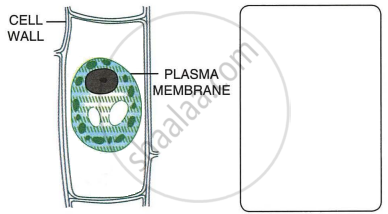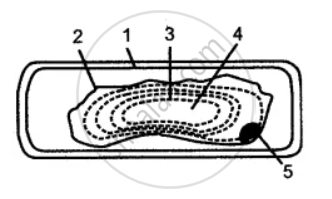Advertisements
Advertisements
प्रश्न
Differentiate between the following
Turgor pressure and Root pressure
उत्तर
| Turgor Pressure | Root Pressure |
| t is the pressure of the cell. Contents of a turgid cell on its cell wall. | It is the pressure under which water passes from the living cells into the xylem of root. |
| It is caused when a cell becomes turgid. | It is caused due to alternate turgidity and flaccidity of root cells. |
APPEARS IN
संबंधित प्रश्न
The diagram given below represents a plant cell after being placed in a strong sugar solution. Study the diagram and answer the questions that follow:

- What is the state of the cell shown in the diagram?
- Name the structure that acts as a selectively permeable membrane.
- Label the parts numbered 1 to 4 in the diagram.
- How can the above cell be brought back to its original condition? Mention the scientific term for the recovery of the cell.
- State any two features of the above plant cell which is not present in animal cells.
The state of a cell in which the cell wall is rigid and stretched by the increase in volume due to the absorption of water is called.
Differentiate between the following:
Turgor pressure and wall pressure
Differentiate between the following:
Turgidity and Flaccidity
Give reason for the following:
A plant cell, when kept in a hypertonic salt solution for about 30 minutes, turns flaccid.
A leaf cell of a water plant was placed in a liquid other than pond water. After sometime, it assumed a shape as shown below:

- Give the term for the state of the cell it has acquired.
- Name the structure which acts as a selectively permeable membrane.
- Comment on the nature (tonicity) of the liquid surrounding the cell.
- Name any one feature of this plant cell which is not present in an animal cell.
- Redraw in the space provided, the diagram of the cell if it is soon placed in ordinary water for some time.
Mention whether the following statement is true (T) or false (F) and give an explanation in support of your answer.
Soaked seeds burst into three seed coats.
The below diagram represents a plant cell after being placed in a strong sugar solution. Guidelines 1 to 5 indicate the following:
1. Cell wall
2. Plasma membrane.
3. Protoplasm
4. Large vacuole
5. Nucleus
Study the diagram and answer the questions that follow :
(i) What is the state of the cell shown in the diagram?
(ii) Name the structure which acts as a selectively permeable membrane.
(iii) If the cell had been placed in distilled water instead of a strong sugar solution which features: would not have been present?
(iv) If the cell in the diagram possessed chloroplasts where would these be present?
(v) Name any one feature of this plant cell which is not present in animal cells.
Name the following:
The condition in which the contents of a cell exert pressure against the cell wall making it distended.
The hydrostatic pressure of the cell sap on the cell wall is called ______.
